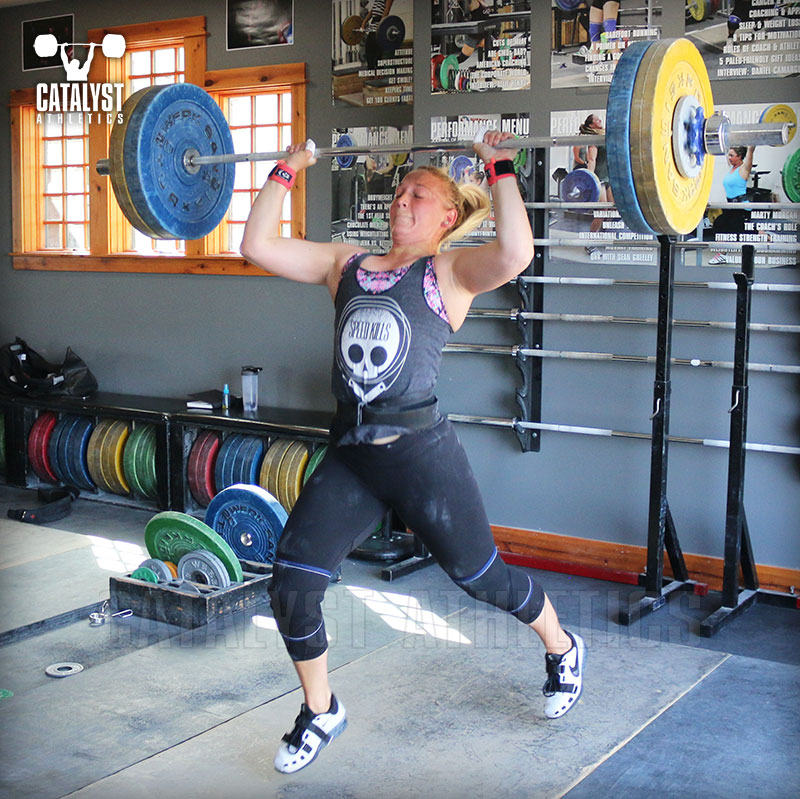Ask Greg: Issue 178

Samantha Asks: My question is a about the timing of getting under the bar in the snatch (and would also apply to the clean). I am someone who is more of a “puller” and not someone who naturally can get under the bar quickly. What are the best drills/methods to learn and practice the timing of the change in direction between the second and third pulls?
Greg Says: The best drill(s) will depend somewhat on why exactly you do this, but let me give you some ideas.
First, we need to distinguish between the speed of the pull under the bar or turnover, and the timing of the change of direction at the top of the pull. You can be extremely fast actually pulling under, but that speed won’t be adequate for successful lifts at heavy weights if your change of direction is too late—the bar will have already lost too much of its upward momentum, leaving you without enough time and space to move under even at maximal speed.
So we need to not only accelerate down under the bar as much as possible, but also time that pull under properly to take advantage of the bar’s existing upward speed to ensure we maximize the time and space available to complete the movement into position under the bar.
The upward speed of the bar actually peaks about halfway through the second pull, so we’re simply trying to maintain as much of that peak speed into complete extension to maximize elevation. That means if we wait too long, we’re really losing speed—past the point we can still effectively “lift” the bar, we’re just giving away time to get under it.
Theoretically the ideal time to start moving under the bar is when the hips, knees and ankles reach their fully extended position. Past that point, we’re continuing to lift the bar just with the arms, which are obviously the weakest links in the pulling chain. Having said that, we want to have some overlap between the final extension of the body and the arms’ pull under rather than a completely clear line of demarcation. This ensures we’re preserving as much speed as possible and maintain continuous force application into the bar.
The best drill to work on the pull under is the tall snatch (or tall clean). This is purely the third pull in isolation and allows you to focus on the mechanics and aggression with no distractions. You can learn, practice and strengthen these movements with muscle snatch and muscle clean variations, which will be slower and easier to control.
To work on a very explosive finish and change of direction, use snatches from power position or clean from power position, and dip snatches and dip cleans. The latter will help you feel more explosive timing, while the former will help you better feel and train a complete leg extension feeding into the finish.
Greg Says: The best drill(s) will depend somewhat on why exactly you do this, but let me give you some ideas.
First, we need to distinguish between the speed of the pull under the bar or turnover, and the timing of the change of direction at the top of the pull. You can be extremely fast actually pulling under, but that speed won’t be adequate for successful lifts at heavy weights if your change of direction is too late—the bar will have already lost too much of its upward momentum, leaving you without enough time and space to move under even at maximal speed.
So we need to not only accelerate down under the bar as much as possible, but also time that pull under properly to take advantage of the bar’s existing upward speed to ensure we maximize the time and space available to complete the movement into position under the bar.
The upward speed of the bar actually peaks about halfway through the second pull, so we’re simply trying to maintain as much of that peak speed into complete extension to maximize elevation. That means if we wait too long, we’re really losing speed—past the point we can still effectively “lift” the bar, we’re just giving away time to get under it.
Theoretically the ideal time to start moving under the bar is when the hips, knees and ankles reach their fully extended position. Past that point, we’re continuing to lift the bar just with the arms, which are obviously the weakest links in the pulling chain. Having said that, we want to have some overlap between the final extension of the body and the arms’ pull under rather than a completely clear line of demarcation. This ensures we’re preserving as much speed as possible and maintain continuous force application into the bar.
The best drill to work on the pull under is the tall snatch (or tall clean). This is purely the third pull in isolation and allows you to focus on the mechanics and aggression with no distractions. You can learn, practice and strengthen these movements with muscle snatch and muscle clean variations, which will be slower and easier to control.
To work on a very explosive finish and change of direction, use snatches from power position or clean from power position, and dip snatches and dip cleans. The latter will help you feel more explosive timing, while the former will help you better feel and train a complete leg extension feeding into the finish.
| Greg Everett is the owner of Catalyst Athletics, publisher of The Performance Menu Journal and author of Olympic Weightlifting: A Complete Guide for Athletes & Coaches, Olympic Weightlifting for Sports, and The Portable Greg Everett, and is the writer, director, producer, editor, etc of the independent documentary American Weightlifting. Follow him on Facebook here. |
Search Articles
Article Categories
Sort by Author
Sort by Issue & Date
Article Categories
Sort by Author
Sort by Issue & Date

